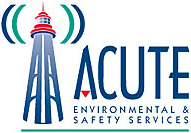ACUTE delivers training in English and participants need to demonstrate an independent understanding and comprehension of the course content to successfully complete the training.

ACUTE delivers training in English and participants need to demonstrate an independent understanding and comprehension of the course content to successfully complete the training.
Prerequisites
None
Program Content
There are many types of potentially hazardous energy including, electrical, thermal, chemical, pneumatic, hydraulic, mechanical and gravitational energy.
All hazardous forms of energy must be locked out, blocked or released to ensure that machinery or equipment does not turn on or move during installation, repair or maintenance.
This training program will teach students the methods and the legislative requirements for hazardous energy control (Lockout) in the workplace.
Training program topics include:
Lock-out/Tag-out definitions
Legislative requirements
General responsibilities
Factors to consider when locking out equipment (R.A.C.E.)
Lockout procedures
Preparation for Lock-out/Tag-out
Machine or equipment shutdown and isolation
Application of Lock-out/Tag-out
Verification of isolation
Lock-out/Tag-out interruption
Release from Lock-out/Tag-out
CSA Standard Z460 Control of hazardous energy – Lockout and other methods
You will learn by:
Classroom interaction with experienced instructors
Exploring legislative requirements
Demonstration and hands-on training in the care and use of equipment
Detailed handouts, videos and quizzes
Who should enroll in this training program?
Employers, supervisors and workers who may be involved with planning or performing work that may expose a worker to hazardous energy will find this course beneficial.
Maintenance workers, industrial equipment operators, millwrights, electricians, HVAC technicians are just a few of the occupations that will find the practical application of this course helpful.
ACUTE was established in 1995 when a group of experienced environmental contractors took their knowledge and experience gained from years of field work to create a company that would ultimately serve its clientele.
By providing comprehensive health and safety training, consulting and on-site safety services. Early in ACUTE’s history we completed a series of large-scale environmental projects such as decommissioning of Great Lakes lighthouse Fresnel lamps.
Which involved the removal of substantial quantities of toxic liquid mercury from lamp ballasts and contaminated surfaces. Projects such as these demanded very detailed safety and logistics planning and served as the primary catalyst for ACUTE’s rise.
To becoming a leader in health and safety services for Canadian workplaces. Health and safety training soon became and remains to this day ACUTE’s premier area of service.
To further strengthen our safety training services we have established one of the province’s best worker training facilities to complement in class training with hands-on practical competency testing.
© 2025 coursetakers.com All Rights Reserved. Terms and Conditions of use | Privacy Policy